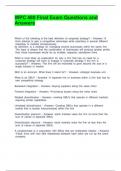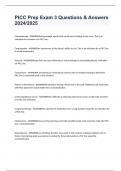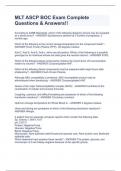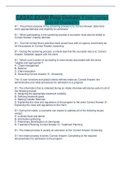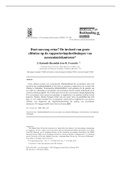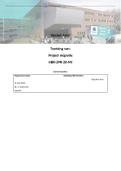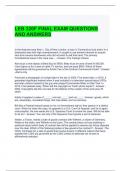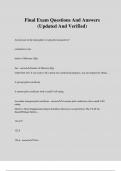Part II
Summary of the book
Table of Contents
Capital structure ...................................................................................................................................... 2
Chapter 14 – Capital structure in a perfect market.............................................................................. 2
Chapter 15 – Debt and taxes............................................................................................................... 4
Chapter 16 – Financial distress, managerial incentives and information ............................................ 6
Chapter 17 – Pay-out policy .............................................................................................................. 10
Chapter 18 – Capital budgeting and valuation with leverage ............................................................ 14
Options .................................................................................................................................................. 17
Chapter 20 – Financial options .......................................................................................................... 17
Chapter 21 – Option valuation ........................................................................................................... 21
Long-term financing ............................................................................................................................... 25
Chapter 23 – Raising equity capital ................................................................................................... 25
Chapter 24 – Debt financing .............................................................................................................. 28
Chapter 25 – Leasing ........................................................................................................................ 31
Short-term financing .............................................................................................................................. 34
Chapter 26 – Working capital management ...................................................................................... 34
Chapter 27 – Short-term financial planning ....................................................................................... 37
Special topics......................................................................................................................................... 39
Chapter 28 – Mergers and acquisitions ............................................................................................. 39
Chapter 29 – Corporate governance ................................................................................................. 42
Chapter 30 – Risk management ........................................................................................................ 45
1
, Capital structure
Chapter 14 – Capital structure in a perfect market
14.1 Equity versus debt financing
Capital structure are the relative proportions of debt, equity and other securities that a firm has outstanding.
→ A firm can be financed with equity. Equity in a firm with no debt is called
unlevered equity. A project’s NPV represents the value to the initial owners of
the firm created by the project. This will be equal to the cash flows. The risk of
the project will also equal the risk of unlevered equity.
→ A firm can also be financed with equity and debt. Equity in a
firm that also has debt outstanding is called levered equity.
Promised payments to debt holders must be made before any
payments to equity holders are distributed. What price E should
the levered equity sell for? Modigliani and Miller (MM) argued that with perfect capital markets, the total
value of a firm should not depend on its capital structure: a firm’s total cash flows still equals the cash flow of
the project, and therefore have the same present value of $1000 calculated earlier. Thus, the cash flows of
the debt and equity sum to the cash flows the projects, and the levered equity must be $1000 - $500 = $500.
People thought leverage would affect a firm’s value and that the value of the levered equity would be:
thus exceeding the $500. But, leverage increases the risk of the equity of a firm, thus we have to use
a different discount rate than 15%. Levered equity
holders want to be compensated for the higher risk, so
they will receive a higher expected return of 25% (see
table). The debt’s return bears no systematic risk, so
their risk premium is zero, but levered equity has twice
the systematic risk of unlevered equity.
→ Thus, leverage increases the risk of equity even when there
is no risk that the firm will default.
14.2 Modigliani-Miller I: Leverage, arbitrage and firm value
MM argue that leverage would not affect the total value of the firm if there is a perfect capital markets:
1. Investors and firms can trade the same set of securities at competitive market prices equal to the present
value of their future cash flows.
2. There are no taxes, transactions costs, or issuance costs associated with security trading
3. A firm’s financing decisions do not change the cash flow generated by its investments, nor do they reveal
new information about them.
→ MM proposition I: In a perfect capital market, the total value of a firm’s securities is equal to the market
value of the total cash flows generated by its assets and is not affected by its choice of capital structure.
As long as the firm’s choice of securities does not change the cash flows
generated by its assets, the decision will not change the total value of the
firm or the amount of capital it can raise. If an investor prefers an alternative
capital structure than the one the firm has chosen, it can borrow the money
on their own and achieve the same result (use homemade leverage) (first
table). An investors can even replicate the payoffs of unlevered equity by
buying both the debt and the equity of the firm (second table).
One application of MM proposition I is the market value
balance sheet. This is similar to an accounting balance
sheet, but includes all assets and liabilities of the firm
(also intangible ones) and all values are current market
values rather than historical costs. The choice of capital
structure does not change the value of the firm, it only
divides the value of the firm into different securities.
Market Value of Equity = Market Value of Assets –
Market Value of Debt and Other Liabilities
2
,A firm repurchasing a significant percentage of its
outstanding shares with borrowed money to increase its
leverage, is called leveraged recapitalization. On the
right, there is an example of a firm that borrows $80
to buy 20 shares. The value per share will stay the same (200/50 or 120/30): the firm has sold $80 debt and
purchased $80 existing equity, this zero-NPV transaction does not change the value for shareholders.
14.3 Modigliani-Miller II: Leverage, risk and the cost of capital
MM proposition I states that: E + D = U = A (Equity + Debt = Market value of equity if firm is unlevered = market
value of the firm’s assets). Thus, the total market value of the firm’s securities is equal to the market value of its
assets, whether the firm is unlevered or levered. The return of a portfolio is equal to the weighted average of the
returns of the securities in it, this equality implies the following relationship between the returns of levered equity
(RE), debt (RD) and unlevered equity (RU): and:
Thus, the levered equity return equals the unlevered return, plus an extra ‘kick’ due to leverage. This extra effect
pushes the returns of levered equity even higher when the firm performs well (R U > RD), but makes them drop
even lower when the firm does poorly (RU < RD). The amount of additional risk depends on the amount of
leverage, measured by the firm’s market value debt-equity ratio, D/E. The second equation is for realized returns,
but it also holds for expected returns (r in stead of R):
→ MM proposition II: The cost of capital of levered equity
increases with the firm’s market value debt-equity ratio:
If we use this equation for the example of the first part, we can see that the expected
return on equity for a levered firm is in line with the percentage discussed above:
If a firm is financed with both equity and debt, then the risk of its underlying assets will match the risk of a portfolio
of its equity and debt. Thus, the appropriate cost of capital for the firm’s assets is the cost of capital of this
portfolio, which is simply the weighted average of the firm’s equity and debt cost of capital, called unlevered Cost
of Capital or Pretax WACC:
Since we are in a perfect capital market, there are no taxes, so the firm’s WACC and unlevered cost of capital are
the same: . Thus, with perfect capital markets, a firm’s WACC is independent of its capital
structure and is equal to its equity cost of capital if it is unlevered, which matches the cost of capital of its assets.
The figure on the right measures the firm’s leverage in term of its debt-to-value
ratio (D/(E+D)), which is the fraction of the firm’s total value that corresponds to
debt. With no debt, WACC is equal to the unlevered equity cost of capital. If a
firm borrows, its equity cost of capital rises but the firm’s WACC is unchanged.
As debt rises and becomes riskier, the debt cost of capital (rD) will also rise.
→ With perfect capital markets, the firm’s weighted average cost of capital and
therefore also the NPV, is unaffected by how a firm chooses to finance a
new investment.
If a company has multiple securities (so more than equity and debt),
we can calculate rU and rwacc by using the weighted average cost of
capital of all of the firm’s securities (just adding them to the formula
above for rU or rwacc).
A firm’s unlevered or asset beta is the weighted average of its equity and debt beta:
It measures the market risk of the firm’s underlying assets and can be used to asses the cost of capital for
comparable investments. If a firm changes its capital structure, unlevered beta will stay the same but equity beta
will change to reflect the change on its risk:
We measure leverage in terms of the firm’s net debt, which is its debt less its holdings of excess cash or short-
term investments.
3
, 14.4 Capital structure fallacies
1. Leverage can increase a firm’s expected earnings per share and thus
also increase the firm’s stock price. An example shows that the expected
earnings per share will increase with leverage, but MM proposition I states
that these financial transactions have a NPV of zero. This is contradictory,
because we haven’t include risk. If we use the same example but with lower
earnings, the expected earnings per share (EPS) will decrease with
leverage. On the right are some scenarios. This is due to an increasing risk.
Thus, while EPS increases on average, this increase is necessary to
compensate shareholders for the additional risk they are taking, so the
share price does not increase as a result of the transaction.
So, because the firm’s earnings per share and price-earnings are affected by leverage, we cannot reliably
compare these measures across firms with different capital structures. Therefore, preferably use performance
measures that are based on the firm’s earnings before interest (e.g. EBIT) and not P/E ratios.
2. Issuing equity will dilute existing shareholders’ ownership, so debt financing should be used instead.
With dilution is meant that if the firm issues new shares, the cash flows generated by the firm must be divided
among a larger number of shares, thereby reducing the value of each individual share. But, cash is raised by
issuing new shares and this will increase the firm’s assets? The value per share will stay unchanged. Any gain or
loss associated with the transaction will result from the NPV of the investments the firm makes with the funds raised
14.5 MM: Beyond the propositions
Results in this chapter can be interpreted as the conservation of value principle for financial markets: with
perfect capital markets, financial transactions neither add nor destroy value, but instead represent a repackaging
of risk (and therefore return).
Chapter 15 – Debt and taxes
15.1 The interest tax deduction
Interest expenses reduce the amount of corporate tax firms must pay. In the table
on the right, the net income is lower with leverage, thus debt reduces the income
available to equity holders. But, the total amount available to all investors is higher
with leverage. In this example, there is $140 more available to investors, this is the
reduction in taxes due to the leverage ($980 - $840). The gain from tax
deductibility of interest payment is called interest tax shield.
→ Interest tax shield = corporate tax rate x interest payments
15.2 Valuing the interest tax shield
(Cash flows to investors with leverage) = (Cash flows to
investors without leverage) + (Interest tax shield). We change
proposition I of MM to the presence of taxes: the total value of
the levered firm exceeds the value of the firm without leverage
due to the present value of the tax savings from debt.
→ VL = VU + PV(ITS)
Sometimes, a firm has a permanent debt, which makes it
easier to calculate the Interest Tax Shield. Thus, the firm maintains a fixed dollar amount of outstanding debt,
rather than an amount that changes with the size of the firm. The interest tax shield each year is: 𝜏c x rD x D. We
can value the tax shield as a perpetuity:
This formula implies that given a 35% corporate tax rate, for every $1 in new permanent debt that the firm issues,
the value of the firm increase by $0.35. If the debt is not risk-free and the risk-free interest rates are not constant,
we can still calculate the PV(ITS): D is equal to the PV(Future Interest Payments).
Tax benefit of leverage can also be expressed in terms of the weighted average cost of capital. For example,
borrow $100,000 for 10% interest. Due to tax savings, you only pay 6,500/100,000=6.50%. Thus, the tax
deductibility of interest lowers the effective cost of debt financing for the firm, which makes it only r(1- 𝜏c).
4




